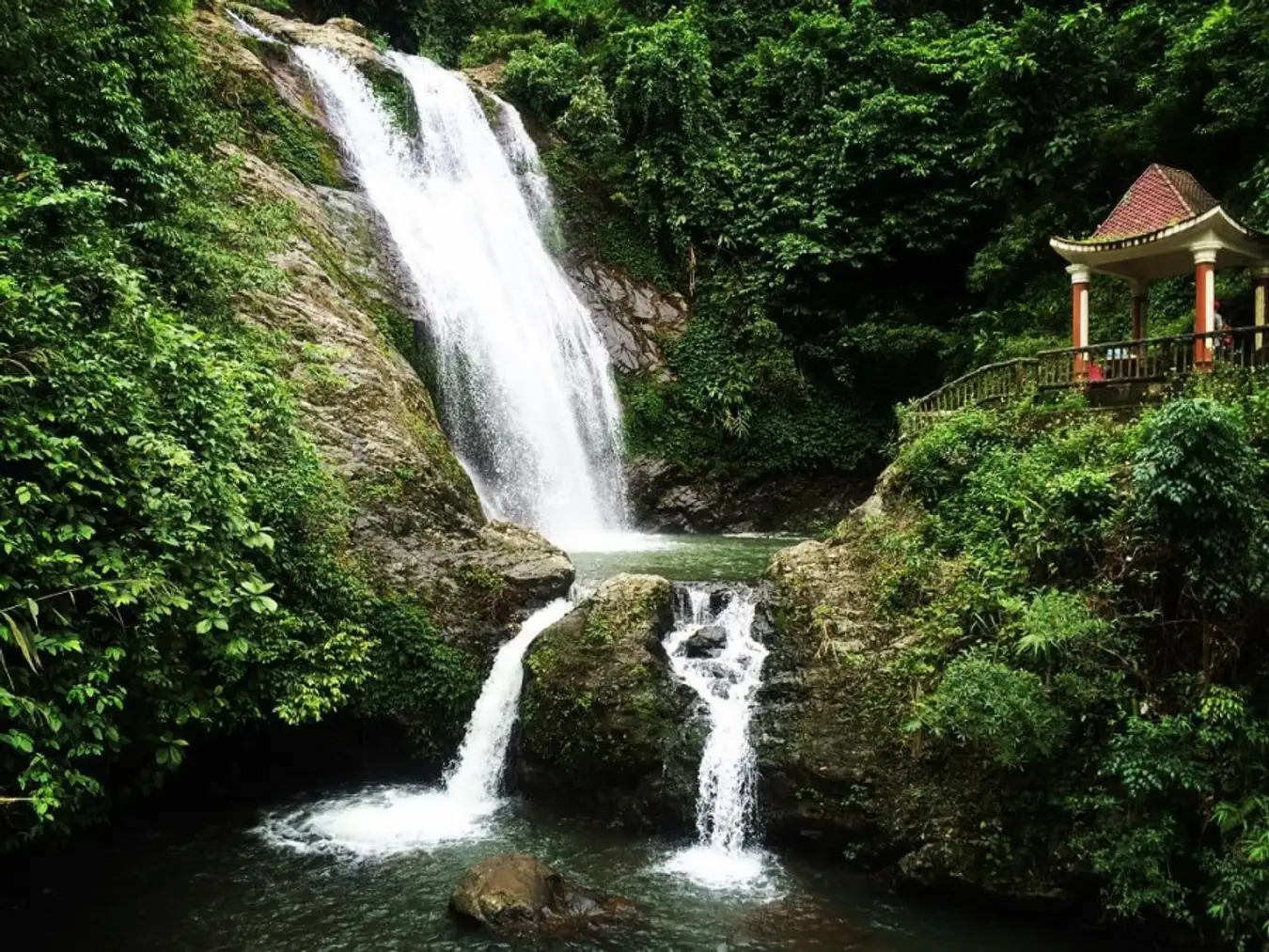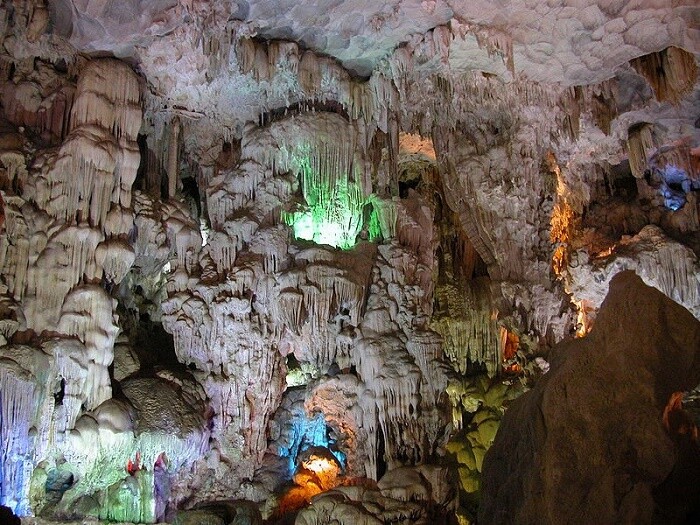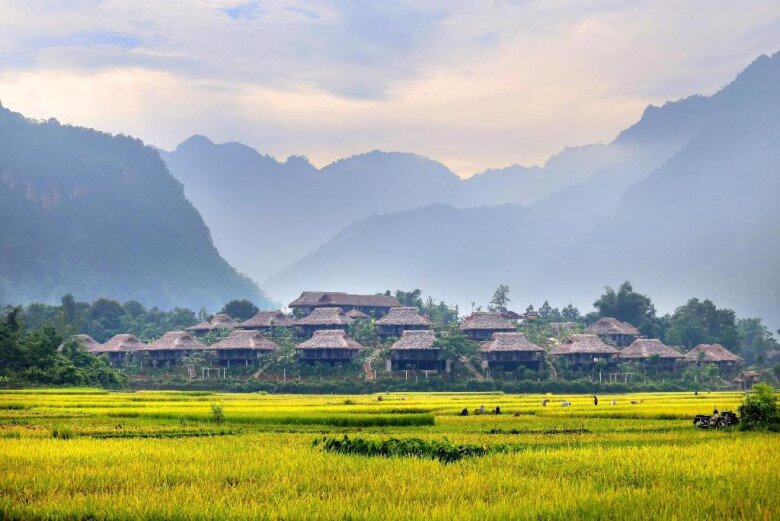Lũng Vân
Lũng Vân offers a breathtaking view of the golden rice terraces and lush greenery. Standing at an elevation of 1200 meters, visitors can enjoy the crisp and cool air, providing a sense of comfort and relaxation.
No matter where you are in Lũng Vân, you’ll have the perfect opportunity to snap some incredible photos. The unique microclimate of the area gives you four seasons in one day: a spring-like morning, a summery noon, an autumn-like afternoon, and a wintery night. Many have likened Lũng Vân to a miniature Đà Lạt in Hòa Bình province.
Lũng Vân is renowned for its pristine natural beauty and majestic scenery. It is also an ideal spot for cloud hunting.

The best time to visit Lũng Vân is from March to May, when the landscape is at its most vibrant.
Cửu Thác Tú Sơn (Nine Waterfalls of Tú Sơn)
Cửu Thác Tú Sơn, often referred to as the “first wonderland of Mường land,” boasts majestic mountains, romantic waterfalls, and a refreshing climate. In recent years, this ecological tourist area has attracted visitors from far and wide.
Located about 40 minutes from Hòa Bình city, the Cửu Thác Tú Sơn ecological tourist area is nestled in Xóm Củ, Tú Sơn commune, Kim Bôi district. As you make your way up to the waterfalls, you’ll be immersed in the rustic and pristine beauty of the landscape and the local Mường ethnic group’s way of life.
Cửu Thác Tú Sơn comprises nine distinct waterfalls, each with its own unique charm, including Thác Tình Âu Cơ, Thác Tiên Tắm, Thác Trải Chiếu Quan Lang, Thác Nàng Út Lót, Thác Bạc, Thác Trượng Phu, Tháng Thượng Ngàn, Thác Mẫu, and Thác Thiên Ngọc Thạch. Walking around the area, you’ll be enveloped by the cool breeze and the sound of rushing water cascading down the cliffs, creating a sense of tranquility and awe.
One of the most fascinating experiences at Cửu Thác Tú Sơn is witnessing the sunrise and sunset. As the sun rises, its golden rays illuminate the waterfalls with a soft yellow hue, and as the day turns to dusk, the waterfalls take on a magical pinkish glow.

The entrance fee to Cửu Thác Tú Sơn is 80,000 VND per person. Along the riverbank, you’ll find small thatched-roof houses where you can rest and enjoy a picnic-style lunch amidst the natural surroundings, making for a memorable experience.
Động Đá Bạc (Silver Stone Cave)
Động Đá Bạc, located in Liên Sơn commune, Lương Sơn district, Hòa Bình province, is accessible by traveling along National Highway 6 towards the west from Hanoi to Xuân Mai town and then continuing on National Highway 21 for another 5 kilometers to the south. From there, you’ll reach Núi Cóc, home to the breathtaking Động Đá Bạc.
Locals often refer to this cave as a “paradise beneath the earth.” With a length of about 70 meters and a width ranging from 4 meters to 22 meters, reaching up to 15 meters at its highest point, Động Đá Bạc is a stunning natural wonder. The cave is divided into three smaller caves: Động Cô Tiên, Động Long Tiên, and Động Mẫu, each with its own unique charm.
Considered a masterpiece of nature, the caves feature fascinating stalactites that form unusual shapes and structures. Illuminated by the glow of lights, these formations take on a myriad of colors, adding to the mystery and allure of the caves.

When gently tapped, the stalactites produce a unique sound, resembling the resonance of gongs and drums. Within the depths of the cave, there lies a large pool of water, formed by the seepage and flow of water from the stalactites, reflecting the colorful lights and creating a mystical ambiance.
Beyond the captivating caves, Động Đá Bạc is also known for its association with the legendary appearance of the sacred flower, the ưu đàm. This flower is said to bloom once every 3,000 years, and if you’re fortunate enough, you may witness its pristine white petals and delicate, shimmering fibers.
Mai Châu Valley
Nestled in a tranquil valley, Mai Châu is a gift from Mother Nature, boasting a serene landscape of lush rice terraces and majestic mountains. The traditional stilt houses of the Thái and Mường ethnic groups dot the landscape, creating a picturesque scene.
In the early morning, mist envelops the stilt houses, lending a poetic and serene atmosphere to the area. The small villages of the Thái people emerge from the morning fog, creating a sense of peace and harmony.
One of the most captivating aspects of Mai Châu is the fusion of nature and local culture. Visitors can immerse themselves in the daily life of the Thái people, experiencing their long-standing customs and traditions. The stilt houses, constructed from wood, bamboo, and thatch, showcase the unique architectural style of the Tây Bắc region.
The Thái people are known for their hospitality, and visitors are often invited to join in activities such as weaving, dancing, and enjoying local specialties like grilled meat, steamed rice, and fish from the streams. The villages of Pom Coọng and Nhót, with their rich cultural heritage, are sure to leave a lasting impression.

During the autumn season, Mai Châu Valley comes alive with the golden hues of ripe rice fields, creating a mesmerizing sight.
Hòa Bình Hydro-electric Lake
The Hòa Bình Hydro-electric Lake, the largest artificial lake in Southeast Asia, stretches over 70 kilometers across 17 communes in five districts of Hòa Bình province. One of its most distinctive features is the scattering of 47 small and large islands, reminiscent of a miniature Ha Long Bay.
Formed on the Đà River, amidst a landscape of limestone mountains, the lake presents a breathtaking vista of islands dotting the green waters. On calm days, the lake becomes a giant mirror, reflecting the clear blue sky and floating clouds, creating a sense of serenity and peace.

In addition to the natural scenery, visitors can explore historical sites such as the Century Letter, the Memorial House, and the tunnel leading to the power generators, offering a fascinating insight into the history of the area.






























